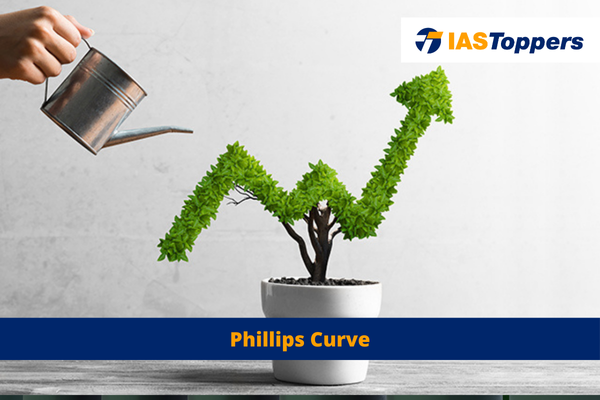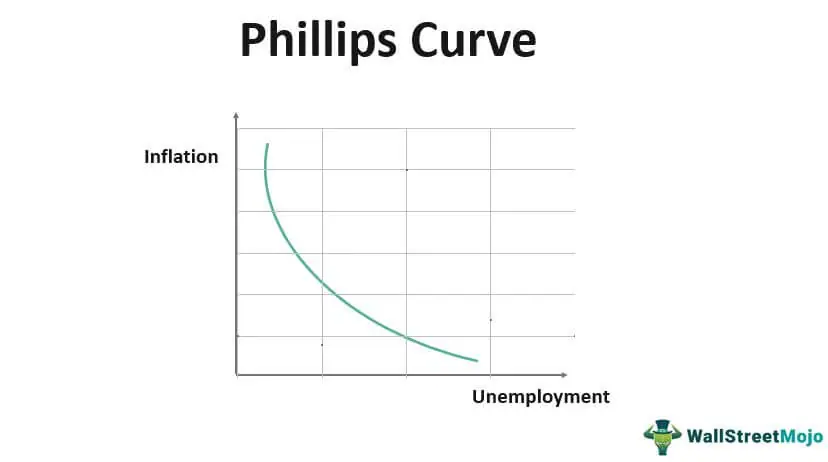The Phillips Curve, named after economist A.W. Phillips, represents the relationship between inflation and unemployment in an economy. It suggests an inverse relationship between these two variables: when unemployment is low, inflation tends to be high, and vice versa. In this article, you will learn definition, characteristics, history, advantages, disadvantages, etc.
This article will provide key insights for GS Paper- II Economy of UPSC IAS Exam.
Table of Content
- What is Phillips curve?
- Characteristics of Phillips curve
- History of Phillips curve
- Advantages of Phillips curve
- Disadvantages of Phillips curve
- Conclusion
- Frequently Asked Questions
What is Phillips curve?
- The Phillips curve is an economic theory that proposes an inverse relationship between inflation and unemployment.
- The theory states that the economic growth leads to inflation, which should result in more jobs and less unemployment.
- This theory was first proposed by William Phillips.
Characteristics of Phillips curve
- The Phillips curve illustrates that changes in unemployment within an economy can influence inflation level.
- It is represented as a downward sloping, concave curve, with inflation on the Y-axis and unemployment on the X-axis.
- Increased inflation decreases unemployment, and vice versa.
- Efforts to reduce unemployment can also lead to higher inflation.
- As per the Phillips curve, any attempt to increase the inflation will decrease the unemployment present in the economy.
- Also, reducing unemployment also increases inflation.
- A trade-off exists between inflation and unemployment.
History of Phillips curve:
- In the 1960s, there was a belief that fiscal stimulus could boost aggregate demand, resulting in increased labour demand and decreased unemployment.
- Companies would raise wages to attract talent, passing those costs to consumers through price increases.
- Governments adopted a “stop-go” strategy to target a specific inflation rate, using fiscal and monetary policies to expand or contract the economy accordingly.
- However, this stable trade-off between inflation and unemployment broke down with stagflation in the 1970s.
- Stagflation occurs when an economy experiences stagnant growth, high unemployment, and inflation.
- This challenges the Phillips curve’s assumptions.
- Stagflation occurs when an economy experiences stagnant growth, high unemployment, and inflation.
- During the 1970s, the U.S. faced stagflation, with rising unemployment accompanied with increasing inflation.
- Economists began to investigate the role of expectations in the relationship between inflation and unemployment.
- Workers and consumers adjust their expectations about future inflation based on current rates, affecting the short-run Phillips curve.
- Over the long run, expectations can adapt, leading to the long-run Phillips curve resembling a vertical line at the Natural Rate of Unemployment (NAIRU).
- The NAIRU represents the normal rate of frictional and institutional unemployment.
- Monetary policy can affect inflation rates, but its impact is limited once expectations have been adjusted.
- During stagflation, expectations of increased inflation due to expansionary monetary policy could shift the short-run Phillips curve outward even before the policy is implemented, resulting in minimal impact on unemployment.
- Ultimately, the short-run Phillips curve also becomes a vertical line at the NAIRU.
Advantages of Phillips curve:
- To achieve the balance between inflation and unemployment, one can use the Phillips curve, which helps to identify the optimal inflation level.
- The indifference curve technique can be utilized to analyse the combination of unemployment.
- The Phillips curve depicts the trade-off between price inflation and unemployment, which indicates the initial strength of the inflation–unemployment relationship.
- Reducing inflation comes at the cost of higher unemployment, while lowering unemployment comes at the cost of higher inflation.
Disadvantages of Phillips curve:
- The relationship between wages and prices operates in two directions such as wages play a significant role in a company’s production cost, thereby influencing the prices of goods.
- Conversely, prices also impact the cost of living, thus influencing wages.
- The Phillips curve, however, focuses only on the influence of wages on prices and overlooks the reverse effect of prices on wages.
- This limitation is more apparent when rising prices increases the living costs, which in turn trigger a rise in wages.
- The Phillips curve concept assumes that inflation is an internal issue, related to the domestic labour market, and neglects the reality that modern inflation is an international phenomenon affecting multiple countries.
- In the 1970s, during the occurrence of stagflation, the implications of the Phillips curve were only valid in the short term, which failed to explain situations when both unemployment and inflation reach at high levels.
- Therefore, the Phillips curve analysis does not hold true during periods of stagflation.
Conclusion
The Phillips Curve, while once a cornerstone of macroeconomic theory, has faced challenges in recent years. Its initial premise, suggesting an inverse relationship between unemployment and inflation, has been questioned due to various factors such as supply shocks, global integration, and changing wage-setting mechanisms. Consequently, the traditional Phillips Curve may not accurately capture the complexities of modern economies.
In conclusion, while the Phillips Curve remains a valuable heuristic tool for understanding the dynamics between inflation and unemployment, policymakers must approach its use with caution, considering its limitations in the context of contemporary economic realities. Recognizing the multifaceted nature of inflation and unemployment dynamics is crucial for formulating effective policy responses to achieve stable economic growth and mitigate adverse consequences on society.
Ref:Source-1
| Other Articles in Economy | |
| Infrastructure investment trusts (InvITs) | Foreign Exchange Rate |
| Narasimham Committee I and II | Difference between Direct Tax and Indirect Tax |
| Prompt Corrective Action | Capitalism |
FAQs (Frequently Asked Questions)
What is the Phillips curve?
The Phillips curve is an economic theory that inflation and unemployment have a stable and inverse relationship.
Why is Phillips curve negative?
Phillips Curve turns negative because nominal demand growth generates a negative correlation between inflation and unemployment.



